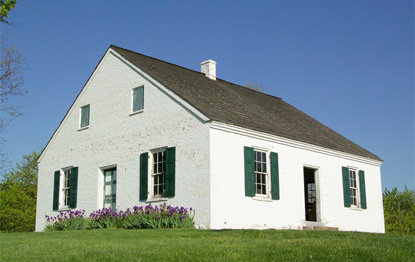 After losing his brother Pressley only days earlier, Daniel marched with the Seventh all night on the 16th from Harper’s Ferry to arrive at Sharpsburg just after 7 a.m. on the 17th. Around 9 a.m. the Seventh with Kershaw’s Brigade accompanied by Colonel George T. Anderson’s Brigade of Georgians rushed the southern edge of the West Woods, behind the Dunker Church, with their arms at the right shoulder shift. Anderson’s Georgia Brigade in the lead advanced to the stubble field six hundred yards south of the Dunker Church before they came under Yankee fire. Anderson’s men went prone and Kershaw’s South Carolinians passed over them and double quicked to the West Woods. They pushed through the West Woods and attacked the left flank of the 125th Pennsylvania, as they neared the Pennsylvanians Kershaw’s men dropped their rifles into their hands and opened fire. The Yankees were also taking heavy fire from General Jubal Early’s Brigade from the right. The Confederates continued pounding the unreinforced Pennsylvanians until they collapsed into a full rout. Kershaw drove them through the West Woods and formed up in front of the Dunker Church.
After losing his brother Pressley only days earlier, Daniel marched with the Seventh all night on the 16th from Harper’s Ferry to arrive at Sharpsburg just after 7 a.m. on the 17th. Around 9 a.m. the Seventh with Kershaw’s Brigade accompanied by Colonel George T. Anderson’s Brigade of Georgians rushed the southern edge of the West Woods, behind the Dunker Church, with their arms at the right shoulder shift. Anderson’s Georgia Brigade in the lead advanced to the stubble field six hundred yards south of the Dunker Church before they came under Yankee fire. Anderson’s men went prone and Kershaw’s South Carolinians passed over them and double quicked to the West Woods. They pushed through the West Woods and attacked the left flank of the 125th Pennsylvania, as they neared the Pennsylvanians Kershaw’s men dropped their rifles into their hands and opened fire. The Yankees were also taking heavy fire from General Jubal Early’s Brigade from the right. The Confederates continued pounding the unreinforced Pennsylvanians until they collapsed into a full rout. Kershaw drove them through the West Woods and formed up in front of the Dunker Church.
 The survivors of the 125th Pennsylvania were caught between Battery D of the 1st Rhode Island Battery and Kershaw’s Brigade. The frantic Pennsylvania troops ran into and pushed through Kershaw’s moving column, many of whom were wearing blue uniforms, adding to the confusion the Yankees were experiencing. The 125th’s colonel passed beside one of Kershaw’s regimental color bearers and later reported considering seizing the banner before scrambling to the safety of his own batteries. Kershaw’s men charged across the Hagerstown Pike toward the Federals as Woodruff’s Battery to their right rear opened up on them. Despite large gaps in their lines, Kershaw’s South Carolinians pressed on. The Pennsylvanians fell back and lay down behind the battery to return fire. Tyndale’s Brigade of Ohioans fixed bayonets and took aim at the South Carolinians as they neared the guns. The Ohio brigade fired on Kershaw’s men at twenty-five yards. Kershaw’s Brigade managed to hold for a few minutes before retiring to the West Woods. There they were reinforced by Ransom’s Brigade and together formed for a second advance.
The survivors of the 125th Pennsylvania were caught between Battery D of the 1st Rhode Island Battery and Kershaw’s Brigade. The frantic Pennsylvania troops ran into and pushed through Kershaw’s moving column, many of whom were wearing blue uniforms, adding to the confusion the Yankees were experiencing. The 125th’s colonel passed beside one of Kershaw’s regimental color bearers and later reported considering seizing the banner before scrambling to the safety of his own batteries. Kershaw’s men charged across the Hagerstown Pike toward the Federals as Woodruff’s Battery to their right rear opened up on them. Despite large gaps in their lines, Kershaw’s South Carolinians pressed on. The Pennsylvanians fell back and lay down behind the battery to return fire. Tyndale’s Brigade of Ohioans fixed bayonets and took aim at the South Carolinians as they neared the guns. The Ohio brigade fired on Kershaw’s men at twenty-five yards. Kershaw’s Brigade managed to hold for a few minutes before retiring to the West Woods. There they were reinforced by Ransom’s Brigade and together formed for a second advance.
The federals repositioned their artillery to defend against Kershaw’s advance. Kershaw’s troops closed in on the Mumma farm for a second time. They charged across the Pike into the mouths of two batteries, their muzzles throwing a wall of flaming lead into their charging line. The survivors retreated into the West Woods, leaving the ground littered with the dead and dying of the Third and Seventh South Carolina Regiments. The Seventh’s colors lay covering the body of the last member of its color guard. Kershaw lost over half of his men in this attack.
One wounded South Carolinian called out to Private Fred Gerhard – one of the 125th Pennsylvania’s men scavenging through the weapons and provisions of the dead. He asked to be moved into the shade. Gerhard attempted to help him, but upon discovering that the Carolinian could not walk because he was partially disemboweled laid him back down and left him in the sun. He reasoned it that it was useless to expend the energy on a dying man. One federal sergeant scraped the brains of a Confederate from the muzzle of Thomas M. Aldrich’s cannon and kept them as a souvenir. As Kershaw’s and Ransom’s men retreated, Confederate sharpshooters were picking off Union artillery men. Kershaw’s survivors reformed along the ridge west of the Dunker Church and fired volleys down upon the Yankees with great effect. During about forty minutes of fighting, the Seventh lost one hundred forty of the two hundred sixty-eight men engaged. Their own Colonel D. Wyatt Aiken was wounded at the muzzle of the northern cannons.
He was struck in the left chest between the heart and the lung. Aiken lay prostrate behind a fallen tree being peppered by enemy fire. Captain Thomas Hudgins of Company B carried Colonel Aiken to the rear and placed him behind a large log and gave him water. Aiken’s wound appeared to be mortal, so Hudgins loosened his colonel’s sword and promised that he would return it to Aiken’s family back in Abbeville County. Private Augustus M. Aiken of Company C, the colonel’s brother, and his servant, Limas soon reached the place where Aiken laid suffering. Believing he did not have much time, Aiken instructed them to bury him in Virginia until after the war then to move his body home to Rock (Presbyterian) Church in Abbeville District. Aiken, with the help of his brother, rolled himself onto his elbows and knees so that the draining blood could cleanse his wound. As the fighting moved off toward the Sunken Road, Gus Aiken and Limas were able to move his brother to a nearby house. The two men spirited the colonel across the Potomac River after dark in a canoe to Sheperdstown in what is now West Virginia. So severe were his wounds that Colonel Aiken’s obituary would appear in the Charleston Daily Courier two weeks later on September 30. To paraphrase Mark Twain, however; the rumors of his death were greatly exaggerated. Colonel Aiken would indeed survive his wounds and recover in time to lead his men at Gettysburg.
Also wounded that day was Daniel’s and Pressley’s close friend James H. Alewine. On September 26, James was admitted to General Hospital No. 4 in Richmond, Virginia with a “Gunshot Wound.” His age was listed as 23 at the time. On September 30th he would be sent home to recover.
Nominated for Best History book of 2012 by the Military Writers Society of America.
To read the entries thus far in the Sesquicentennial series for The Boys of Diamond Hill click here.
To learn more click on the “Diamond Hill” link at the top. To buy the book you may go to any major online retailer such as Amazon or Barnes and Noble, or you may buy it directly from McFarland Publishers. “The Boys of Diamond Hill” is also available for the Kindle.




